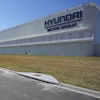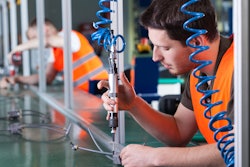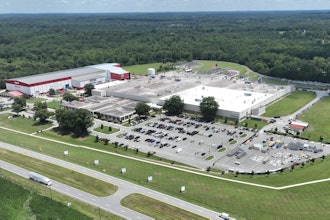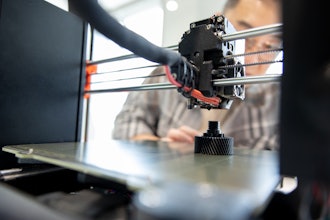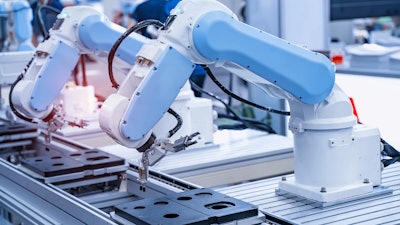
When it comes to specifying miniature motors, application designers always have to weigh speed, torque and cost. But technology advancements present new challenges that push the limits of traditional motor designs. For example, robotic arms and shrinking medical devices demand high-performance motors that fit in a limited space. Other applications may call for a high-speed motor that also has to be cost-effective enough to use in a disposable device. And, still more applications need custom motors fine-tuned to fit an application’s specific requirements.
 Robotic arms and small, motorized devices for surgical procedures demand compact yet reliable motors.
Robotic arms and small, motorized devices for surgical procedures demand compact yet reliable motors.
Because customers have ever-changing requirements, motor manufacturers can’t afford to simply stay status quo with the changes. In order to be truly customer-focused, they must listen to the engineer in order to rethink and innovate motor and motion technologies for future requirements.
That’s why Portescap’s product development process is based on customer insights. Through the Voice of the Customer process, we harness our users’ technical insights and turn them into innovative motion products that solve complex problems for their critical applications. These collaborations have sparked various different Portescap product platforms, and all of them are 100 percent customizable. We also leverage search optimization technology to determine whether customer searches can reveal an opportunity to innovate and deliver to market.
When a customer-inspired initiative begins, we use the well-established and respected stage-gate product development process. The stage-gate process navigates a product idea from concept to business case to production using a list of well-defined actions. We also use lean management principles for determining whether a product idea is scalable. Teams take ownership of the product at each step while receiving user reviews and feedback along the way.
By listening to the customer to address their previously unmet needs, our Voice of the Customer process has delivered many innovative new motor platforms. Here are just a few examples:
Innovations for Robotics, Life Sciences and Other Industrial Applications
Robotics designers are attracted to BLDC motors thanks to their robustness, long life and ability to perform at high speeds. In addition, BLDC motors may also help reduce design sizes. User feedback led us to create a proprietary u-shaped coil that integrates larger copper fittings to give the coil higher performance than a standard straight coil but with smaller size and minimal iron losses, better efficiency and cooler operation. In fact, the design allows two-pole motors, for example, to deliver 30 percent more torque compared to the same size motor. BLDC slotless motors that incorporate u-coils can be tailored for high-speed, high-torque or a balance of both.
 Using just a thin sheet of rare earth magnet material in disc form, this motor platform achieves fine step resolutions and provides high dynamic response for gripping applications.
Using just a thin sheet of rare earth magnet material in disc form, this motor platform achieves fine step resolutions and provides high dynamic response for gripping applications.
Another common requirement for robotic applications is high dynamic response. Robotic grippers need a combination of fast, incremental precision that a stepper motor can provide as well as the speed and acceleration typical of brushless DC motors. There’s a new way to achieve the benefits of both motor types: Harness the power of a rare earth magnet while using just a thin sheet of magnet material in disc form. This concept enables finer step resolutions than permanent magnet stepper motors in a given envelope, significantly higher acceleration due to low inertia and greater top speed than conventional steppers due to a shorter magnetic circuit presenting lower iron losses.
 Low-inertia Disc Magnet Motor technology allows this actuator to achieve quick linear acceleration and deceleration within the same low-profile package.
Low-inertia Disc Magnet Motor technology allows this actuator to achieve quick linear acceleration and deceleration within the same low-profile package.
Low-inertia disc magnet technology can also apply to actuators, enabling quick linear acceleration and deceleration within one low-profile package to save process time. That means engineers can simplify their designs as they solve complex application challenges.
 Robotic arms with complex motion profiles require high-performance motorized components that must fit into limited spaces.
Robotic arms with complex motion profiles require high-performance motorized components that must fit into limited spaces.
If a machine must perform both linear and rotary motion, each motion type will require separate motorized control components. However, such bulky and complicated designs are undesirable for space-constrained automated equipment and robots. An innovative way to allow simultaneous linear and rotary motion involves combining two permanent stepper motors into one lightweight, compact package, resulting in a simpler design.
 The Dual Motion Can Stack Actuator stacks two permanent stepper motors within one package to provide linear and rotary motion simultaneously.
The Dual Motion Can Stack Actuator stacks two permanent stepper motors within one package to provide linear and rotary motion simultaneously.
The actuator design delivers pure linear motion in any direction without shaft rotation, pure rotation — clockwise or anti-clockwise — with no shaft translation along its axis, or combined linear motion and rotation simultaneously in any direction.
Innovations Ideal for Medical and Surgical Applications
Failure is not an option for small medical devices that require compact motors. Yet, brushed DC motors are subject to wear that can affect a device’s reliability. Mechanical wear causes a reduction in the brush’s thickness. To alert users to potential failure due to wear, we added an extra terminal between the power source and the motor where the connections are located. The device controller sends data pertaining to the brush thickness to the network so users can monitor the motor. This smart platform is particularly desirable for healthcare applications such as medical pumps, x-ray machines and lab analyzers as well as industrial pumps or any small, motorized device where reliability is critical.
 Disposable surgical tools rely on economical high-speed motors.
Disposable surgical tools rely on economical high-speed motors.
For applications that require high rotational speeds, high-rpm brushless DC motors can be an attractive choice. However, if the BLDC motor only needs to run for a few minutes in a disposable instrument, for example, high speed may not justify the cost. As small, disposable surgical tools like those used in atherectomy surgeries become more prevalent, they need an economical high-speed motor option. In response, we developed a new coreless brushed motor concept that incorporates a modified brush material and ball bearings to deliver high speed operation to devices with short lifetimes.
 Portescap’s Athlonix DCP coreless brushed DC motor can be modified with additional sleeves to increase the stator’s diameter for better torque performance.
Portescap’s Athlonix DCP coreless brushed DC motor can be modified with additional sleeves to increase the stator’s diameter for better torque performance.
The result: speeds surpass 10,000 rpm and can even reach 40,000 rpm for several minutes of usage before disposal. Its optimized design also minimizes EMI — a key issue our customers have told us they focus on when considering a brushed DC motor.
 Portescap’s High-Speed platform features a coreless design with a modified brush material and ball bearings to achieve high rpms for devices with short lifetimes.
Portescap’s High-Speed platform features a coreless design with a modified brush material and ball bearings to achieve high rpms for devices with short lifetimes.
Portescap Innovations Solve Current and Future Challenges
These emerging motion and motor platforms started with a designer's challenge and Portescap focusing on what’s possible in the next three to five years. Whether you’re designing a robot with hard-to-satisfy torque and speed requirements or a critically needed disposable medical instrument that needs a fast and cost-effective motor, your insights will help Portescap create a custom miniature motor to both meet your current challenges and shape future designs.
For more information, visit Portescap’s Motion Innovations page.


